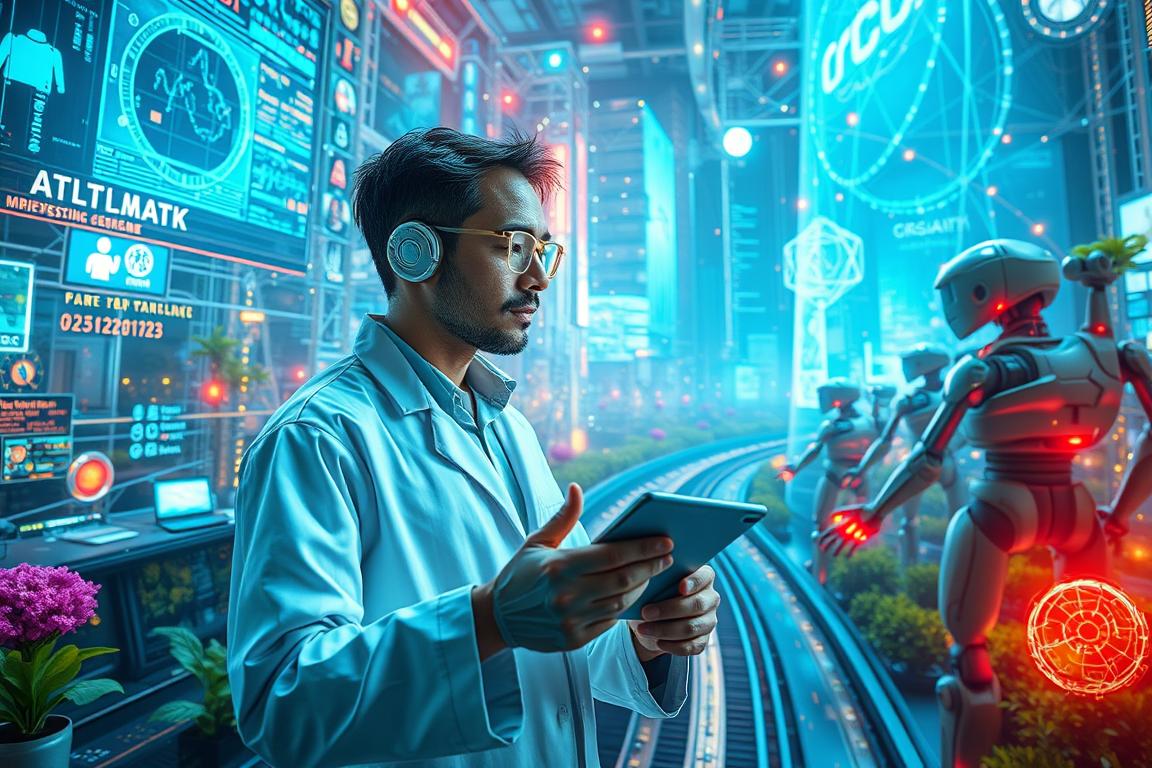Welcome to the exciting world of artificial intelligence, led by Dr. Nova, a symbol of science AI. This AI scientist guide will help you understand AI better. You’ll learn about the roles, responsibilities, and skills needed in this fast-growing field.
Dr. Nova, a cutting-edge AI model, shows how technology can help in research. It analyzes data, translates texts, and assists in writing for subjects like biology and nanomedicine.
Let’s dive into this changing world. Think about how virtual scientists like Dr. Nova help us grasp data and make big discoveries. With over 30 billion conversations by chatbots like Xiaoice, the connection between tech and humans is key. Let’s start our deep dive into artificial intelligence, showing its big impact on science today and tomorrow.
Understanding the Role of an AI Scientist
The AI scientist role is key to advancing artificial intelligence. These experts create algorithms, do deep research, and analyze big data. Their work is vital for AI in many fields, leading to new tech breakthroughs.
Definition and Responsibilities
An AI scientist does many things:
- They design and make AI models and tools, using advanced skills.
- They do thorough research to find new AI ways.
- They work with teams to add AI to current systems.
This job needs both creativity and technical skills. It’s perfect for those with a strong computer science background.
Skills Required
To do well in this role, you need certain skills for AI:
- You should know programming languages like Python and R for data work.
- Understanding statistics and math is crucial.
- Being good at solving problems is key for working with complex data.
The best AI scientists keep learning and adapt. This helps them stay up-to-date with AI’s fast changes.
Career Pathways
The career pathways for AI roles are wide and varied. Some possible jobs are:
- Data scientists focus on finding insights and making predictions.
- AI engineers build and use AI systems.
- Machine Learning engineers work on improving algorithms and models.
Many start as junior data scientists or engineers. They then move up to senior roles like principal data scientist. The need for AI skills is growing, showing how important they are in today’s job world.
The Evolution of Artificial Intelligence
The history of AI is a thrilling story of growth from its first ideas to major breakthroughs. It shows us important moments in AI’s journey and the people who made big changes. Knowing these stories helps us see how AI has changed many fields.
Key Milestones in AI Development
In the 1950s, AI’s roots began when scientists started using computers to play games like checkers and chess. Some key moments include:
- The Dartmouth Summer Research Project in 1956, where John McCarthy first used the term “artificial intelligence.”
- IBM’s Deep Blue beating chess world champion Garry Kasparov in 1997, showing AI’s strength.
- The shift to data-driven AI in the late 1990s and early 2000s, improving machine learning.
- AlphaGo’s win over Lee Sedol in 2016, proving deep learning’s skill in complex games.
Influential Figures in AI History
Many important people have shaped AI’s history. Their work has made AI what it is today. Key figures include:
- Alan Turing – He set the stage for modern computing and AI with the Turing Test.
- John McCarthy – A true pioneer, he introduced the term AI and held the first AI conference.
- Geoffrey Hinton – Known as the “Godfather of Deep Learning,” his work has led to AI’s current state.
Major Fields of Study in AI
The fields of AI offer many chances for researchers and innovators. These areas use different methods and apply to many industries. Knowing these specializations helps those who want to work in AI.
Machine Learning
Machine learning is key in AI. It uses algorithms and models for computers to do tasks without being told. It’s about finding patterns and making predictions based on data. People in this field use Python and R to create complex models.
Natural Language Processing
Natural language processing (NLP) helps computers understand human language. It’s used in chatbots, translation, and analyzing feelings. NLP experts use linguistics and statistics to improve how humans and computers talk.
Computer Vision
Computer vision lets machines understand visual data. It’s about teaching computers to see and understand images. This field has grown thanks to deep learning, leading to new uses in healthcare and cars.
Robotics
Robotics combines AI with engineering for smart machines. It’s about making robots that can do things on their own. By mixing machine learning and robotics, we see new ways to automate and improve AI.
Tools and Technologies for AI Scientists
The field of artificial intelligence uses many tools and technologies. These help AI scientists to innovate and do research well. Knowing the key parts of this tech world can make AI projects more productive and efficient.
Programming Languages
Python is a top choice for AI because it’s easy to read and has lots of libraries for machine learning and data analysis. R is also great for AI research, especially in statistical computing. Java and C++ are other important languages, each with its own strengths for AI development.
Software Frameworks
Software frameworks make AI development easier. TensorFlow and PyTorch are popular because they help implement complex algorithms and make machine learning tasks simpler. These frameworks offer libraries and tools to help AI scientists build, train, and improve models more efficiently.
Cloud Computing Resources
Cloud computing is key for AI scientists working with big data and complex tasks. Services like Amazon Web Services (AWS) and Google Cloud Platform offer scalable computing and storage. This lets AI scientists process huge amounts of data. Using the cloud also helps with teamwork and developing AI tools for real-time data analysis and monitoring.
Data – The Foundation of AI
Data is key for artificial intelligence, helping systems learn and make smart choices. It’s important to know about different data types and how to handle them for those in this field.
Types of Data Used
AI uses both structured and unstructured data. Structured data, like in databases, has a set format, making it simpler to manage. Unstructured data, like images and text, needs more complex methods to get useful insights. Each type of data helps improve how well AI algorithms work and how accurate they are.
Data Collection Techniques
Getting the right data is crucial. There are many ways to collect data, such as:
- Surveys and questionnaires to gather user feedback
- Web scraping to obtain data from online sources
- APIs to extract data from services
- Sensor data from IoT devices
Companies that focus on these methods often have large, detailed datasets. This gives them a big advantage in making smart decisions.
Data Preprocessing
Before analyzing data, preprocessing is essential. This step cleans raw data by removing errors and making values consistent. Techniques like transformation and aggregation make the data ready for use. Good data preprocessing is key to AI model success, showing the value of starting with clean data for the best AI results.
Ethical Considerations in AI Research
The world of artificial intelligence is changing fast. This brings up many ethical questions for researchers. One big issue is AI bias, caused by the data and algorithms used to train AI. This bias can unfairly treat people, especially those from underrepresented groups.
For example, women of color are 32% more likely to be misclassified by facial-recognition technology than White people. This shows how important it is to understand and address AI bias.
Understanding Bias in AI
AI bias can affect important areas like healthcare and self-driving cars. Researchers are working on making AI more transparent and fair. This is crucial as AI systems get more complex and the chance of bias grows.
With AI-powered weapons, there are also questions about ethics and rules. This has led to talks about needing global laws for their use.
Regulations Governing AI
AI rules are getting stricter. U.S. agencies are warning about AI bias and thinking about how to make companies responsible. The White House has put $140 million into solving AI’s ethical problems.
This shows a big effort to make AI fair and accountable. AI scientists must follow ethical rules and push for responsible use in their work.
Collaborative Projects in AI
The world of artificial intelligence grows thanks to teamwork. Projects that bring together different fields are key to its progress. By mixing neuroscience, psychology, and engineering, AI gets better and helps many areas.
Interdisciplinary Approaches
Looking at AI from many angles helps experts solve big problems. For instance, in healthcare, AI helps doctors by using medical science and data. In finance, AI fights fraud and helps with customer service.
Importance of Teamwork
Working together sparks new ideas. Teams with people from different backgrounds offer fresh views and ways to solve problems. This teamwork leads to big breakthroughs, like safer and more efficient cars.
Staying Informed: AI in the News
Keeping up with AI news is key for anyone interested. Many sources share insights on AI progress and research. Reading AI publications and going to AI conferences helps you understand AI better.
Key Publications and Journals
Many AI publications share important knowledge. “The Batch” by deeplearning.ai sends a weekly newsletter with big updates. It’s written by experts like Andrew Ng.
Medium has deep articles from leaders and researchers. Journals like the Journal of Artificial Intelligence Research (JAIR) and ArXiv.org are also vital. They publish the latest research and tech advancements.
Conferences and Symposiums
Going to AI conferences is a great way to meet experts. Events like NeurIPS, AI Expo, and The AI Summit have talks from top professionals. They discuss the newest AI innovations.
These events are great for teamwork and learning about AI trends and ethics.
Future Trends in AI
The world of artificial intelligence is changing fast. New technologies in AI are set to change its future. These innovations will have a big impact on many industries.
Emerging Technologies
Artificial General Intelligence (AGI) is a big trend. It aims to make AI as smart as humans. Most AI today is Narrow AI, good at one thing. But, new tech like quantum computing and better neural networks could change everything.
Generative AI is also exciting. An AWS survey found 80% think it will change companies. But, only 6% use it now. This shows a big gap between what’s possible and what’s used.
Predicted Impact on Industries
AI is set to make a big splash in healthcare, finance, and education. In healthcare, AI can help doctors make better diagnoses and suggest better treatments. This makes healthcare more accessible.
In finance, AI can manage money better than humans. This could change how we invest. Education might see a big change too. AI could create learning plans just for each student.
AI in cars is also growing fast. From 8% in 2015 to 109% by 2025. This shows how AI can change how we travel.
The need for data scientists is growing. But, there’s a new trend called citizen data science. It’s important for AI experts to keep up with these new trends. This way, they can help their companies and industries grow.
Becoming an AI Scientist: A Step-by-Step Guide
Starting your journey as an AI scientist needs careful planning and a commitment to learning. You’ll first get a Bachelor’s Degree in computer science or data science. This lays the groundwork for AI knowledge.
Going for advanced degrees can boost your skills. Many schools offer special AI courses. These help you dive deep into the subject.
Educational Pathways
Online learning sites like Coursera and edX are also great. They offer courses on programming, algorithms, and data management. These are key for AI scientists.
The Certified Artificial Intelligence Scientist (CAIS™) program is another good option. It’s from the United States Artificial Intelligence Institute. It helps you learn quickly and efficiently.
Gaining Practical Experience
Getting hands-on experience is just as important as education. Internships and real projects improve your skills. They also show you the real-world challenges.
Working on projects with others strengthens your knowledge. This experience is crucial for job hunting. The demand for AI scientists is expected to grow by 21% by 2031.
Building a Professional Network
Creating a network in AI is key to success. Go to conferences, join online forums, and find mentors. These steps can open doors and give you insights.
Sharing your knowledge and connecting with experts keeps you updated. The AI market is set to hit $738.80 billion by 2030. Building connections can lead to exciting career opportunities.







